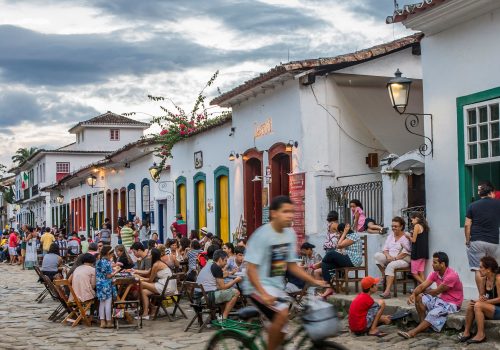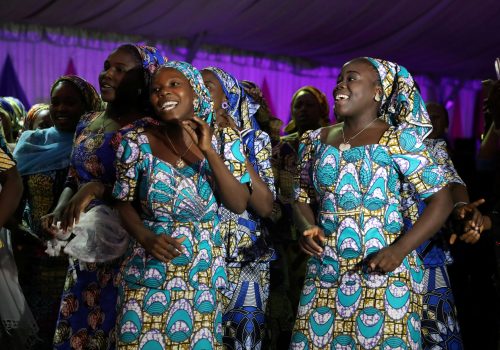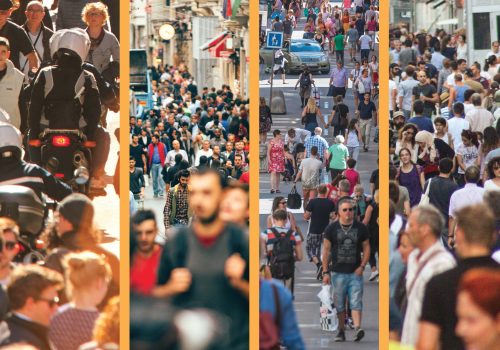With the UN General Assembly underway, keep freedom at the forefront
The seventy-eighth United Nations General Assembly (UNGA) is under way this week in New York, and the schedule is packed. Leaders are taking part in a high-level forum about the Sustainable Development Goals (SDGs), which are at the halfway point between their adoption in 2015 and the 2030 deadline for their achievement. This SDG forum follows events such as the United Nations South-South Cooperation Day, which emphasized sharing knowledge and expertise between developing countries, and the International Day of Democracy, which focused on the role of young people in promoting democratic systems in their countries.
At the heart of these gatherings lie two profound concepts: freedom and prosperity. While freedom in particular is often associated with Western nations, the UNGA serves as a powerful reminder that this aspiration is not exclusive to any region or group; rather, freedom is a fundamental human right that deserves recognition and promotion worldwide. The events at the UNGA demonstrate efforts from countries across the globe toward creating a freer world. Data from the Atlantic Council’s Freedom and Prosperity Indexes give credibility to these efforts and show that freedom is both present and actively pursued in all regions of the world.
The distribution of freedom across regions
The Freedom and Prosperity Indexes use a diverse set of data to provide a unique and comprehensive measurement of both freedom and prosperity in 164 countries. The Freedom Index uses a total of thirteen indicators to measure economic (free-market economy), political (democracy and individual rights), and legal (the rule of law) freedom in each country.
The 2022 data show that freedom varies across regions of the world, with Europe (and especially Western Europe) appearing the freest. Thirty of the forty-five “free” countries (shown as dark green in the scatterplot) in the world are in Europe, including the top nine countries (Denmark and Sweden lead the world with scores of 95.1 and 93.5 out of 100, respectively). North America is also a free region, with the United States and Canada scoring in the “free” category and Mexico in the “mostly free” category.
In the middle of the pack, the regions of Central and South America and East Asia and the Pacific both score above the global average. The two regions, however, are quite different in terms of their distribution. Central and South America is relatively homogenous, with most countries scoring in the “mostly free category,” followed by a few “free” (Costa Rica, Chile, and Barbados) and “mostly unfree” (El Salvador, Haiti, and Nicaragua) countries. By comparison, East Asia and the Pacific is much more varied in its distribution, with a large portion of countries in the “free,” “mostly free,” and “mostly unfree” categories. Australia, New Zealand, and Japan are some of the freest countries in the world, with scores of 90.8 (10th), 90.6 (11th), and 85.2 (23rd), while other countries in the region such as Cambodia, China, and Myanmar fare much more poorly with scores of 40.9 (140th), 39.6 (144th), and 26.8 (158th).
While also in the middle, Sub-Saharan Africa scores below the global average and contains several countries in the “mostly free,” “mostly unfree,” and “unfree” categories. South Sudan and Eritrea are some of the world’s least “free” countries with scores of 19.1 (162nd) and 17.5 (163rd). The Democratic Republic of the Congo and Nigeria fall into the “mostly unfree” category, while Kenya, South Africa, and Ghana are “mostly free.” Seychelles and Cape Verde are the region’s two “free” countries with scores of 79.8 (35th) and 78.8 (40th).
On the other end of the spectrum, the Middle East and North Africa (MENA) and South and Central Asia are the least free regions, with their countries generally falling in the “mostly unfree” and “unfree” categories (shown as light and dark red in the scatterplot). Afghanistan and Turkmenistan are among the world’s least free countries with scores of 14.4 (164th) and 20.7 (161st), and Yemen and Syria have scores of 26.6 (159th) and 21.2 (160th).
Freedom exists and is being pursued in all corners of the world
Out of the 164 countries measured in our index, forty-five are considered “free.” Although the Freedom Index shows that the majority of the “free” countries lie mainly in Western Europe and North America, it is important to note that there are “free” countries throughout the world, showing that freedom can and does exist everywhere and is not unique to the West.
In fact, there are a handful of nations that have outperformed their regional peers in terms of institutional stability and quality (i.e., the extent to which these institutions are able to provide a stable, predictable, and transparent framework for economic, social, and political activities within a country) to reach the highest category of freedom. These include South Korea and Japan in East Asia and the Pacific with scores of 80.6 (34th) and 85.2 (23rd), Seychelles and Cape Verde in Sub-Saharan Africa with scores of 79.8 (35th) and 78.8 (40th), and Costa Rica and Chile in Central and South America with scores of 82.6 (28th) and 81.4 (31st). Though these countries are very different culturally and geographically, they are united in that they promote freedom through economic, political, and legal dimensions.
Even more countries are upgrading their freedoms and noticeably improving their scores. Our data track freedom from 1995 to 2022. During this time, the global average in freedom rose slightly, climbing around three points in our Freedom Index. Numerous countries around the world, however, experienced a larger increase in freedom, with the top improvers achieving gains of more than twenty-five points. Notably, these countries are not concentrated in one region, but are dispersed throughout the globe. In fact, examining the graph below shows that the countries with the biggest improvements in freedom hail from many different regions: Sub-Saharan Africa claims four of the top ten freedom improvers. Europe contributes three. And South and Central Asia, East Asia and the Pacific, and Central and South America each have one. Notably, all ten of the countries that have advanced the most in freedom scored below the global average in 1995. But by 2022, nine of these countries had risen above the global average.
Largest advancements in freedom, 1995-2022
Freedom is being actively pursued and achieved across the entire globe, as the largest improvements in freedom are not confined to one region. Countries such as Sierra Leone, Indonesia, and Bhutan are proving that freedom is a valued concept regardless of culture or region, and that nations do not need to adopt Western practices or attitudes to obtain freedom. Freedom looks different in different places, and it is up to each country to find the best-fitting recipe to improve economic, political, and legal policies that guarantee a high degree of sustainable freedom.
Nina Dannaoui is the associate director for the Freedom and Prosperity Center at the Atlantic Council.
James Storen is the program assistant for the Freedom and Prosperity Center.
Further reading
Thu, Jun 15, 2023
Prosperity that lasts: The 2023 Freedom and Prosperity Indexes
Report By Dan Negrea, Joseph Lemoine
The 2023 Freedom and Prosperity Indexes measure the distribution of freedom and prosperity in 164 countries. The report explores the relationship between the two and identifies global and regional trends over the last twenty-eight years.
Mon, Sep 18, 2023
The freedom and prosperity equation: Government interventions in Nigeria
The Freedom and Prosperity Equation By
The Nigerian government should prioritize assuring economic and legal freedoms, with a focus on reducing its involvement in the economy and enhancing its role in providing security.
Wed, Jun 1, 2022
Do countries need freedom to achieve prosperity?
Report By Dan Negrea, Joseph Lemoine, Matthew Kroenig, Joel Kesselbrenner
The Freedom Index and Prosperity Index are two separate indexes that rank one hundred and seventy-four countries around the world according to their levels of freedom and prosperity.
Image: US President Joe Biden addresses the 78th Session of the UN General Assembly in New York City, US, September 19, 2023. REUTERS/Caitlin Ochs


